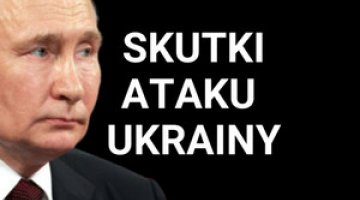Record number of Russian drones strike Ukraine. Day 1091 of the war


The Russians continue their assault on the flanks of the Pokrovsk agglomeration. After weeks of fighting, they managed to capture the area of the junction on the main road from Pokrovsk to Kostiantynivka. They also significantly expanded the area they control to the north-east of it. After a break of several days, they also resumed operations in the area around Velyka Novosilka, achieving success to the west of it. According to some sources, they also led a probing attack towards Kostiantynivka from the direction of the previously occupied Toretsk. The attack on Ulakly west of Kurakhove accelerated the liquidation of the salient where Ukrainian forces had been holding out. The defenders mostly retreated to the west, with their last centre of resistance in the area being the junction of Kostiantynopil in the flank.
Russia made further territorial advances in Chasiv Yar and in the vicinity of bridgeheads on the right banks of the Zherebets River towards Lyman and the Oskil River north of Kupiansk. The three-way assaults launched from the nodal Dvoritsa River resulted in a significant widening of the bridgehead beyond the Oskil River, but the area occupied by the Russians is still too small to ensure a stable crossing of the river by larger forces. To the north-east of the current bridgehead on the right bank, they created another one in the area of the village of Topoli. In the Kursk Oblast, Russian troops recaptured Sverdlikovo, the last village before Sudzha on the road leading to that town from the north-west.

On 12 February, Russian missiles struck Kyiv. Ukraine declared that all the ballistic missiles used by the enemy had been shot down, but there was a lot of destruction and fires in three areas of the city. A renewed attack on the capital occurred on 17 February. At that time, drone damage to one industrial plant was confirmed. Four times – on 12, 14, 16 and 17 February – the Kyiv Oblast authorities reported damage from drones.
The Russians have again stepped up their attacks on Odesa Oblast. On 13 February, rockets hit its capital and drones hit port infrastructure near Izmail. Damage to port infrastructure also occurred the following day in Odesa Oblast. According to some sources, on 16 February, the rockets targeted the bridge over the Dniester Estuary at Zatoka – one of the most frequently attacked infrastructure facilities by Russia in the oblast.
On 14 February, a Russian drone struck the non-functioning reactor 4 of the Chernobyl nuclear power plant. According to the chief engineer, it pierced the New Safe Confinement installed in 2019 and exploded inside, and the barrier designed to prevent the spread of radioactive substances ceased to function. The invaders are thought to have used the Shahed/Geran unmanned aircraft in an upgraded version. The International Atomic Energy Agency announced that there was no leakage of hazardous substances or increase in radiation levels.
Two days later, Russian drones severely damaged the Mykolaiv thermal power plant. The installations responsible for generating electricity were thought to have been destroyed. Heating of the city was restored the following day. Other targets of Russian missiles or drones included Kryvyi Rih (11 February), Sumy (13 February) and Kryvyi Rih (twice on 17 February), while damage to critical infrastructure facilities was reported in Chernihiv and Mykolaiv oblasts (12 February). As a result of the attack on 17 February, Kyiv and the Kyiv and Dnipropetrovsk oblastsexperienced an emergency disconnection of energy supplies. From the evening of 11 February until the morning of 18 February, Russia used a total of 932 drones – thus setting another record after the one recorded a week earlier, when they used 790 drones. According to Ukraine, 543 drones were downed and 359 were lost locally. The Russians were also said to have used 19 rockets, six of which were shot down (all over Kyiv).

As a result of an attack by Ukrainian drones on 17 February on the Kropotkinskaya pumping station in Krasnodar Krai, Kazakh oil supplies to the West were temporarily cut off. The Ilsky refinery was also targeted, but there is no confirmation that the strike caused significant damage.
Russian operations against Ukraine
On 12 February, Ukrainian counterintelligence detained the chief of staff of the Anti-Terrorist Centre of the Security Service of Ukraine, Dmytro Koziura. He was alleged of having collaborated with the FSB since 2018. As an officer with more than 20 years of experience, he had access to top-secret information, data and the personnel characteristics of SBU employees. Head of the service Vasyl Malyuk stated that Koziura had been under operational control for some time prior to his detention and had been used to feed disinformation to the enemy.

On 12 February, the 26th meeting of the contact group of countries supporting Ukraine militarily took place in the Ramstein format. UK Defence Secretary John Healey announced that £150 mn will be spent, from the £4.5 billion planned for Kyiv in 2025 in a new package for tanks and armoured combat vehicles (around 50, including T-72 tanks; due to arrive at the front “by the end of spring”), artillery, air-to-air missiles and the refurbishment of previously donated armaments. The German delegation notified that Ukraine would soon receive around 100 missiles for IRIS-T systems, and Dutch Defence Minister Ruben Brekelmans announced 25 YPR tracked medical evacuation carriers. The following day, Norway’s Ministry of Defence confirmed the provision of air defence assets worth $107 million to the Ukrainian army out of the $2 billion allocated for military support in 2025. Norway also joined the ‘drone coalition’ and donated $50 million to projects as part of it.
On 17 February, the German Chancellery announced a new military support package for Ukraine. This included four Slovak-made Zuzana 2 self-propelled howitzers, 56 MRAP armoured vehicles, ammunition for combat vehicles, 50,000 155mm artillery shells and 2,000 122mm shells, IRIS-T air defence missiles, reconnaissance drones (245 RQ-35, 51 Vector, 29 Songbird and 14 Hornet), 300 HF-1 circulating ammunition and small arms with 60 million rounds.

On 11 February, the Prosecutor General’s Office of Ukraine reported that 1,039 criminal cases against commanders of various levels for negligent performance of official duties and 198 cases for arbitrary desertion from the battlefield were processed in 2022–2024. The number of sentences handed down is abnormally low – 59. During martial law, the Criminal Code for violation of Article 425 (negligence in relation to military service) provides for military commanders to be punished with imprisonment of five to eight years, and the commission of an offence under Article 429 of the Criminal Code (unauthorised abandonment of the battlefield or refusal to use weapons) is punishable by imprisonment of five to ten years.
On 11 February, the Ukrainian government approved a procedure to conclude one-year contracts for volunteers aged between 18 and 24. The terms of the contracts provide for basic general military training, specialised training and an adaptation course in a military unit. Those covered by the procedure will receive a one-time gratuity of 1 million hryvnias (about $25,000) paid in instalments (200,000 hryvnias upon signing the contract, 300,000 upon completion of training, 500,000 on discharge) and 120,000 hryvnias (over $2,800) per month salary. Additional bonuses for performing combat missions and compensation for renting a flat for the duration of the contract, followed by the possibility of obtaining an interest-free mortgage, were also provided for. A spokesman for the Ministry of Defence provided assurances that the new funding rules would also be retrospectively applied to volunteers aged between 18 and 24, who had already joined the army before the current rules came into force.
The rules introduced for recruiting volunteers were criticised by the editor-in-chief of the Censor.net news website, Yuri Butusov. He considered them unfair and insufficient and revealed that they are only intended to cover six brigades. He further pointed out that such high payouts to new soldiers would create an increased sense of injustice among experienced personnel who have been fighting at the front for a long time, while preferential rules would discourage men over 24 from joining the service.
On 11 February, in an interview with The Economist, President Volodymyr Zelensky stated that in 2024, approximately 30,000 people were mobilised every month. At the same time, he acknowledged that Russia mobilises 45,000 troops per month and that the size of its army varies between 1.5 million and 1.9 million men, and announced that the manpower level in the Ukrainian brigades is at 50–60%.
A day later, Deputy Head of the Office of the President of Ukraine Pavlo Palisa confirmed that the formation of new brigades in the Ukrainian army had ceased and that the focus was on the reconstruction of existing brigades. Brigades that have already been formed or are in the final stages of formation will continue training.

On 12 February, in an interview with The Guardian newspaper, President Zelensky said, citing military intelligence information, that Russia plans to increase its army by 12–15 divisions this year, equivalent to about 150,000 troops. He added that Ukraine currently has 110 brigades. In Munich, meanwhile, he announced that Russia intends to send an additional 2–3,000 North Korean troops to the Kursk Oblast.





